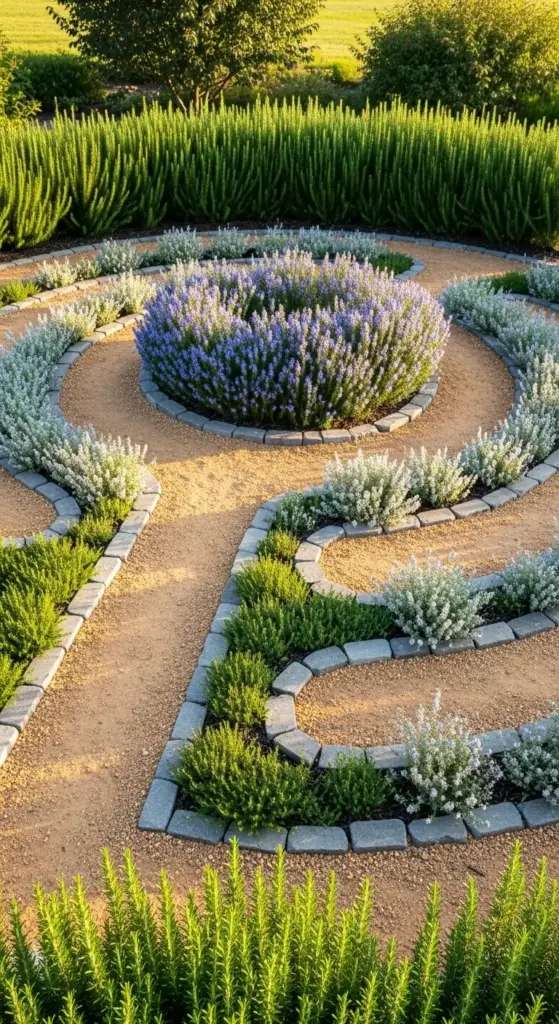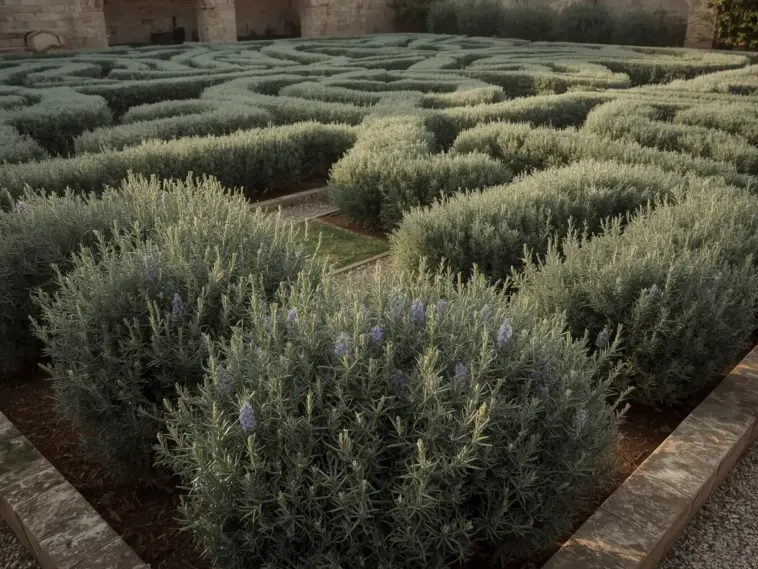Have you ever wondered why monastery gardens feel so peaceful and perfectly designed? There’s actually a fascinating secret behind their timeless beauty!
For over 500 years, monks have been cultivating rosemary in ways that modern gardeners are just beginning to rediscover. These aren’t just pretty plants – they’re carefully orchestrated design masterpieces that combine functionality, beauty, and spiritual tranquility.
I’ve spent years studying these hidden techniques, and what I found will completely transform how you think about garden design.
From creating natural room dividers to designing aromatic pathways that guide visitors through your space, these monastery secrets will elevate your outdoor sanctuary to something truly extraordinary.
Ready to unlock centuries of gardening wisdom?
1. The Sacred Spiral: Creating Meditative Rosemary Labyrinths

I’ll never forget the first time I walked through a monastery garden in Tuscany and stumbled upon this incredible rosemary spiral. The monks had created this mesmerizing pattern that seemed to pull you in, and honestly, I stood there for like twenty minutes just breathing in that amazing scent.
That moment changed everything for me. I knew I had to recreate that peaceful, meditative experience in my own backyard.
Designing Your First Rosemary Spiral Pattern
Here’s the thing about spiral garden design – it’s way easier than it looks, but I definitely made some rookie mistakes my first time around.
I started by marking the center point with a wooden stake. Then I used a rope to create perfect circles, spacing them about 18 inches apart.
The key is starting small – my first spiral was only 8 feet across. Trust me, you can always expand later, but trying to maintain a massive spiral right off the bat is overwhelming.
I learned the hard way that you need at least three complete turns for that true labyrinth effect. Two turns just looks like a weird circle, and four gets too complicated for beginners.
Choosing Rosemary Varieties for Visual Impact
This is where I got really excited (and maybe a little obsessed). Different rosemary cultivars create incredible texture variations when you plant them strategically.
For the outer rings, I use upright rosemary varieties like ‘Tuscan Blue’ – they can reach 4-6 feet tall and create that dramatic backdrop. In the middle sections, ‘Miss Jessup’s Upright’ works perfectly at about 3 feet.
The inner spiral gets the low-growing varieties. ‘Prostratus’ stays under 2 feet and has this gorgeous trailing habit that softens the harsh lines.
Here’s what nobody tells you – the color variations are just as important as height. I alternate between the deep blue flowers of ‘Majorca Pink’ and the pale lavender of ‘Arp’ to create visual rhythm.
Creating Mindful Walking Paths
The pathway width was my biggest learning curve. I made my first paths way too narrow – like 18 inches – and it felt cramped and rushed.
Now I stick to 24-30 inch wide paths minimum. This gives you space to walk slowly and actually experience the journey instead of just getting through it.
I use decomposed granite for the walking surface because it’s soft underfoot and drains well. Regular gravel was too crunchy and broke the meditative mood.
The secret sauce? Plant low-growing thyme between the path stones. When you step on it, it releases this incredible fragrance that mixes with the rosemary.
Natural Stone Borders That Actually Work
My first attempt at stone edging was a disaster. I just laid random rocks along the spiral and they shifted everywhere within a month.
Now I dig a shallow trench about 4 inches deep and 6 inches wide. I lay the stones so they’re sitting about 2 inches below ground level – this keeps them stable and creates clean lines.
Fieldstone works best because the irregular shapes look natural, but limestone is easier to work with if you’re a perfectionist like me. Each stone should be roughly the same height – about 6-8 inches above ground.
Pro tip I wish someone had told me: wet the stones before placing them. You can see the true colors and textures, which helps create a more cohesive look.
Year-Round Maintenance Secrets
Here’s the reality check – rosemary spiral maintenance is ongoing, but it’s actually pretty therapeutic once you get into a routine.
I do light pruning every 6 weeks during growing season. The key is never cutting more than one-third of the plant at once, or you’ll stress it out.
Spring is when I reshape the spiral definition. I use string lines to keep the curves smooth and trim any plants that are growing into the pathways.
The biggest mistake I made early on was letting the center plants get too tall. Now I keep the inner spiral at 12-18 inches max, and it maintains that perfect inward flow.
Weekend DIY Project Breakdown
Saturday morning: Mark your spiral pattern and dig the pathways. This took me about 4 hours for an 8-foot spiral.
Saturday afternoon: Install stone borders and prepare planting holes. Don’t rush this part – good preparation makes everything else easier.
Sunday: Plant your rosemary varieties and add pathway materials. Water everything thoroughly and step back to admire your work.
The whole project cost me about $180 in plants and materials, but the sense of accomplishment was priceless.
Ready to take your rosemary garden to the next level? Click the “next” button below to discover how monastery monks create stunning living walls of fragrance using vertical rosemary techniques that’ll give you complete privacy while filling your space with incredible scents!










GIPHY App Key not set. Please check settings